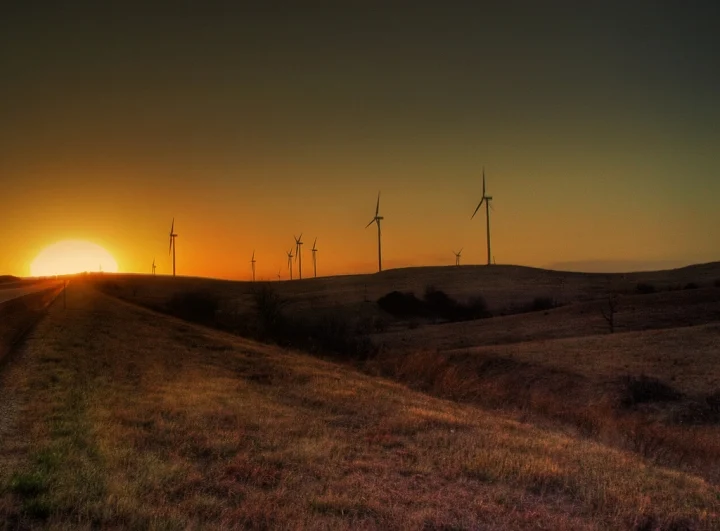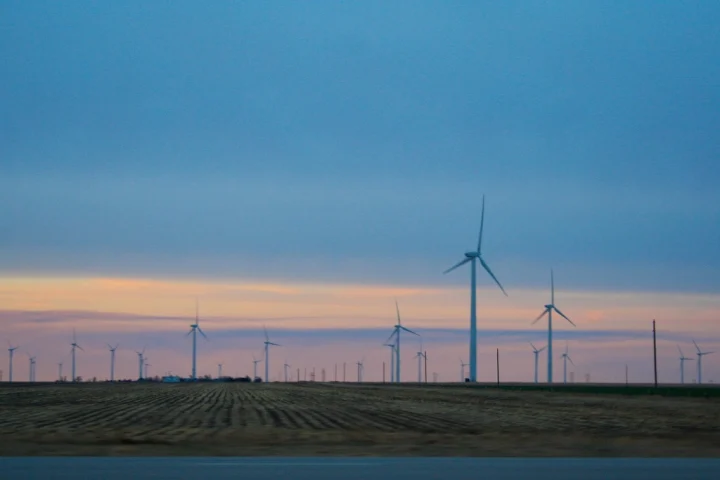News•May 20, 2015
Kansas Takes Air Out of Wind Power Mandate
By Bobby Magill
The renewable power mandate in Kansas, which helped vault the state to become one of the top six wind power producers in the country, may be about to become a victim of its own success. Gov. Sam Brownback is poised to sign a bill repealing the mandate and making it voluntary instead.
Kansas’ mandate requires six major utilities to generate 20 percent of their power from renewables by 2020, a requirement the state met six years early as wind farms sprouted across the Great Plains. Lawmakers there, long against expanding the mandate, are forcing the wind industry to live without a guarantee of a wind market in Kansas, though it is likely to grow anyway because the state has some of the best wind resources in the country.
A wind farm near Hays, Kan.
Credit: Ethan R/flickr

The repeal follows the rollback of renewables mandates in West Virginia and Ohio, but it is unlikely to turn the tide against increasing interest among many states to implement climate change policies that require more electricity to be produced from low-carbon energy sources.
The wind power industry considers a mandate preferable to a voluntary goal because it has the force of law and guarantees a wind power market in a state, Jeffrey Clark, executive director of the Wind Coalition, said.
Those who oppose the renewable mandate, including the Kansas Chamber of Commerce, say the mandate increases the cost of energy for consumers and picks “winners and losers” between renewables and fossil fuels, both of which are abundant in the state. The bipartisan bill passed through the state House by a 105-16 vote and the state Senate by a 35-3 vote.
Renewable energy mandates, or renewable portfolio standards, are in effect in 29 states and are widely seen as one of the best ways to promote clean energy. Eight states have voluntary renewables targets and 13 states, mostly in the South, have no renewables standards or targets at all.
The rising tide of states setting more ambitious renewables and greenhouse gas emissions-cutting goals includes Hawaii, which is poised to mandate that all of its electricity come from wind, solar, geothermal and other renewables by 2045. California is aiming to generate 50 percent of its electricity from non-hydropower renewables by 2030. Five other states, including Michigan, New York, Minnesota, Illinois and Vermont, are considering increasing their standards this year, according to the American Wind Energy Association.
Kansas set its 2020 renewables mandate in 2009, and as the wind industry boomed there, the state met the goal six years early when it generated more than 21 percent of its power from wind in 2014.
RELATEDOkla. Utilities Hit Homes Using Solar With Extra Fee
Sunny Side East: Solar Takes Off in Eastern U.S.
Hawaii Sets Goal of 100% Renewables by 2045
“The renewable energy standard has done its job, essentially,” Jeff Deyette, senior energy analyst for the Union of Concerned Scientists. “It took a state that had very little renewable energy projects operating in the state just six, seven years ago and turned it into a national leader in wind energy developed. The policy did the job it intended to.”
The wind industry is lobbying for states to expand their renewables standards, but insufficient support in the Kansas Legislature—and a desire for a friendly tax climate in the state—forced the industry to compromise. Lawmakers had proposed imposing a 4.3 percent excise tax on wind in Kansas, and part of the compromise was to take the tax off the table while turning the mandate into a voluntary goal, Clark said.
Creating an unenforceable renewables standard in Kansas seemed to be workable because the speed with which the wind blows across the Great Plains all but ensures that the wind industry will not shrink, he said.
“As one of (the) tools states use to grow their renewable generation assets, we would have supported an expansion of the RPS, but this was not politically viable,” Clark said. “Fortunately, other tools exist. We were able to strengthen the state's tax policy toward wind projects and to add predictability that encourages investment. By keeping a business climate that encourages wind development, Kansas will continue to grow.”
The Kansas repeal may give some lobbying groups pushing hard against renewables a reason to celebrate, especially after Ohio temporarily froze its renewables mandate and West Virginia dropped its renewable standard altogether, Deyette said. But the rollback is hardly a precedent-setting success story for those opposed to mandating renewable energy.
Wind turbines twirl over farmland in Kansas.
Credit: Christopher Sebela/flickr

“There’s just no sign that the other states are really interested in going back and rolling back policies,” Deyette said.
The big question, he said, is what happens when states meet their mandate, generating the targeted portion of their electricity from wind, solar and other renewables. Kansas chose to remove the mandate. California and New York are considering expanding theirs. Others aren’t yet sure.
Texas, which produces more wind power than any other state in the country, is considering fully repealing its renewables mandate because, like Kansas, it met its renewable portfolio standard, and wind power production only continues to grow.
Deyette said the Obama administration’s Clean Power Plan, which, if implemented later this year will require greenhouse gas emissions cuts from existing coal-fired power plants, could soon force states to decide the future of their renewables mandates.
“All the states are going to figure out how they comply with that standard and what role renewable energy’s going to play in meeting those emissions reductions targets,” he said. “It’s going to force the conversation over the next several years in virtually every state.”
You May Also Like:
These Are The Amazon Trees That Keep The Planet Cool
Oil Drilling May Slow Drought Recovery in Great Plains
California’s Forests Have Become Climate Polluters
Past 12 Months Tied for Warmest on Record